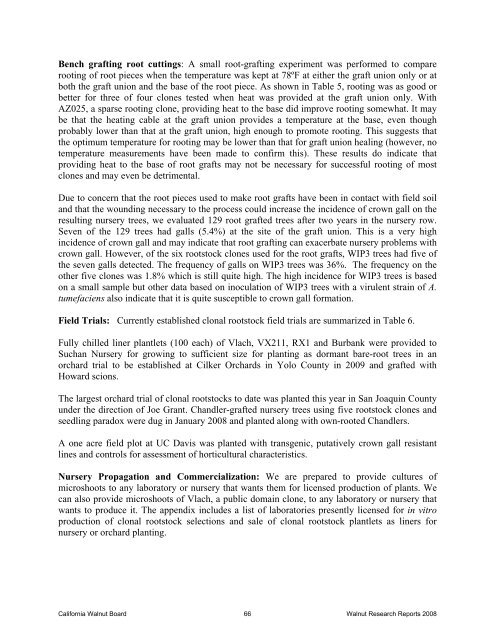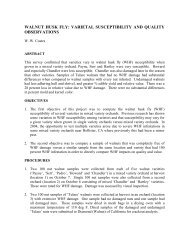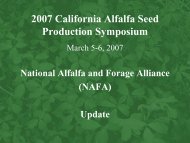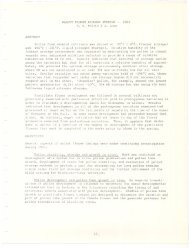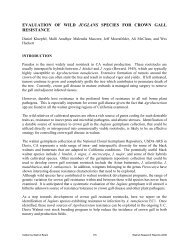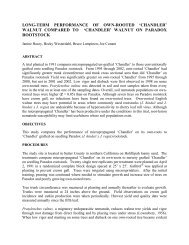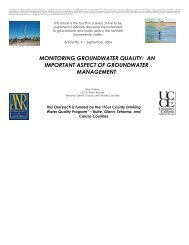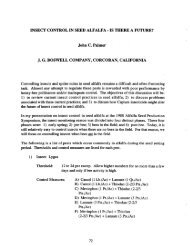clonal propagation of walnut rootstock genotypes for genetic ...
clonal propagation of walnut rootstock genotypes for genetic ...
clonal propagation of walnut rootstock genotypes for genetic ...
You also want an ePaper? Increase the reach of your titles
YUMPU automatically turns print PDFs into web optimized ePapers that Google loves.
Bench grafting root cuttings: A small root-grafting experiment was per<strong>for</strong>med to comparerooting <strong>of</strong> root pieces when the temperature was kept at 78ºF at either the graft union only or atboth the graft union and the base <strong>of</strong> the root piece. As shown in Table 5, rooting was as good orbetter <strong>for</strong> three <strong>of</strong> four clones tested when heat was provided at the graft union only. WithAZ025, a sparse rooting clone, providing heat to the base did improve rooting somewhat. It maybe that the heating cable at the graft union provides a temperature at the base, even thoughprobably lower than that at the graft union, high enough to promote rooting. This suggests thatthe optimum temperature <strong>for</strong> rooting may be lower than that <strong>for</strong> graft union healing (however, notemperature measurements have been made to confirm this). These results do indicate thatproviding heat to the base <strong>of</strong> root grafts may not be necessary <strong>for</strong> successful rooting <strong>of</strong> mostclones and may even be detrimental.Due to concern that the root pieces used to make root grafts have been in contact with field soiland that the wounding necessary to the process could increase the incidence <strong>of</strong> crown gall on theresulting nursery trees, we evaluated 129 root grafted trees after two years in the nursery row.Seven <strong>of</strong> the 129 trees had galls (5.4%) at the site <strong>of</strong> the graft union. This is a very highincidence <strong>of</strong> crown gall and may indicate that root grafting can exacerbate nursery problems withcrown gall. However, <strong>of</strong> the six <strong>rootstock</strong> clones used <strong>for</strong> the root grafts, WIP3 trees had five <strong>of</strong>the seven galls detected. The frequency <strong>of</strong> galls on WIP3 trees was 36%. The frequency on theother five clones was 1.8% which is still quite high. The high incidence <strong>for</strong> WIP3 trees is basedon a small sample but other data based on inoculation <strong>of</strong> WIP3 trees with a virulent strain <strong>of</strong> A.tumefaciens also indicate that it is quite susceptible to crown gall <strong>for</strong>mation.Field Trials: Currently established <strong>clonal</strong> <strong>rootstock</strong> field trials are summarized in Table 6.Fully chilled liner plantlets (100 each) <strong>of</strong> Vlach, VX211, RX1 and Burbank were provided toSuchan Nursery <strong>for</strong> growing to sufficient size <strong>for</strong> planting as dormant bare-root trees in anorchard trial to be established at Cilker Orchards in Yolo County in 2009 and grafted withHoward scions.The largest orchard trial <strong>of</strong> <strong>clonal</strong> <strong>rootstock</strong>s to date was planted this year in San Joaquin Countyunder the direction <strong>of</strong> Joe Grant. Chandler-grafted nursery trees using five <strong>rootstock</strong> clones andseedling paradox were dug in January 2008 and planted along with own-rooted Chandlers.A one acre field plot at UC Davis was planted with transgenic, putatively crown gall resistantlines and controls <strong>for</strong> assessment <strong>of</strong> horticultural characteristics.Nursery Propagation and Commercialization: We are prepared to provide cultures <strong>of</strong>microshoots to any laboratory or nursery that wants them <strong>for</strong> licensed production <strong>of</strong> plants. Wecan also provide microshoots <strong>of</strong> Vlach, a public domain clone, to any laboratory or nursery thatwants to produce it. The appendix includes a list <strong>of</strong> laboratories presently licensed <strong>for</strong> in vitroproduction <strong>of</strong> <strong>clonal</strong> <strong>rootstock</strong> selections and sale <strong>of</strong> <strong>clonal</strong> <strong>rootstock</strong> plantlets as liners <strong>for</strong>nursery or orchard planting.Cali<strong>for</strong>nia Walnut Board 66 Walnut Research Reports 2008


